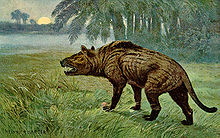Hyaenodon
| Hyaenodon | ||||||||||||
|---|---|---|---|---|---|---|---|---|---|---|---|---|

Skull of Hyaenodon cayluxi in the Muséum national d'Histoire naturelle in Paris |
||||||||||||
| Temporal occurrence | ||||||||||||
| Upper Eocene to Lower Miocene | ||||||||||||
| Locations | ||||||||||||
|
||||||||||||
| Systematics | ||||||||||||
|
||||||||||||
| Scientific name | ||||||||||||
| Hyaenodon | ||||||||||||
| Laizer & Parieu , 1838 | ||||||||||||
Hyaenodon is a genus of the extinct mammalian order Creodonta, or primal carnivores, within which it belongs to the Hyaenodontidae family. The genus was one of the latest in this family and is mainly known from the late Eocene and early Oligocene , but also from the late Oligocene in numerous small and medium-sized species. In the early Miocene there were only a few species left. In 1993, 42 species of the genus were distinguished. Remnants of the widespread genus are known from North America, Europe, Asia and Africa. Some species of the genus were among the most powerful terrestrial carnivores of their time, others stand out due to their particularly small body size, which corresponds only to that of a modern marten.
Types and distribution

In North America the last Hyaenodon with species like H. brevirostris disappeared in the late Oligocene, in Europe with species like H. milloquensis , H. bavaricus and H. leptorhynchus also in the late Oligocene. From the Miocene of Africa, three species ( H. andrewsi , H. matthewi and H. pilgrimi ) are also known, which are occasionally placed in a separate genus Isohyaenodon . However, none of these species reached the dimensions of the Asian species, such as H. gigas and H. weilini . The last Eurasian species seems to have been H. Weilini from the early Miocene
Mainly because of the differences in size, but also because of other morphological features, a distinction is made between two sub-genera: Neohyaenodon with larger species and Protohyaenodon with smaller ones.
There are currently more than half a dozen species of Hyaenodon in the late Paleogene Asia. H. pervagus from the early Oligocene, H. eminus from the late Eocene, H. yuanchensis from the middle Eocene and H. mongoliensis , H. incertus , H. gigas and H. chunkhtensis . The early Miocene species H. weilini is significantly larger than other species of the genus with the exception of H. gigas and the similar species H. mongoliensis . In contrast, H. pumilus from the Upper Eocene is the smallest representative to date. The species was introduced in 2019 using a lower jaw from Ergileen Dzo in southeastern Mongolia.
The larger Hyaenodon (subgenus Neohyaenodon ) of the late Eocene include the North American species H. horridus , which also occurred in the Oligocene, H. montanus and H. megaloides . A smaller species from the earliest Oligocene was H. crucians . More precise estimates for hyaenodon are difficult to determine because the animals had oversized skulls compared to today's predators. According to this, values are obtained for H. horridus that are very far apart at 32 kg and 153 kg, depending on whether one uses the skull length or the head-trunk length as a basis for comparison for the calculations. Recent studies show that adult H. horridus should have weighed around 40 kg and did not exceed 60 kg. H. crucians from the early Oligocene of North America is estimated to be around 10 to 25 kg. The two late Eocene species H. microdon and H. mustelinus were smaller and weighed only about 5 kg.
These particularly small forms also include the Eurasian species H. filholi and H. rossignoli from the late Eocene to Oligocene in Europe and H. chunkhtensis from the Oligocene in Asia.
credentials
- ↑ a b c Xiaoming Wang, Zhanxiang Qiu and Banyue Wang: Hyaenodonts and Carnivorans from the Early Oligocene to Early Miocene of Xianshuihe Formation, Lanzhou Basin, Gansu Province, China. Palaeontologia Electronica 8 (1), 2005, p. 6A, online
- ^ A b Alexander V. Lavrov and Robert J. Emry: Hyaenodon venturae (Hyaenodontidae, Creodonta, Mammalia) from the Early Chadronian (Latest Eocene) of Wyoming. Journal of Paleontology 72 (4), 1998, pp. 752-757
- ↑ А. В. Лавров: Новые материалы по представителям мелких гиенодонов (Hyaenodontinae, Creodonta) из Палеогена Монголии. Палеонтологический Журнал 53 (4), 2019, pp. 93-106
- ^ A b Naoko Egi: Body Mass Estimates in Extinct Mammals from Limb Bone Dimensions: the Case of North American Hyaenodontids. Palaeontology 44 (3), 2001, pp. 497-528 doi: 10.1111 / 1475-4983.00189
Web links
- Hyaenodon horridus ( Memento from November 21, 2008 in the Internet Archive ) (English)
- Hyaenodon Brief Info and Computer Graphics ( Memento from October 17, 2012 in the Internet Archive ) (English)
